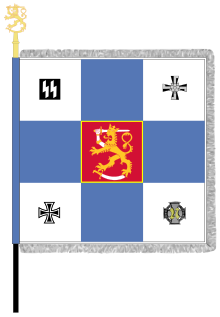| Finnish Volunteer Battalion of the Waffen-SS | |
|---|---|
 Flag of the Finnish Volunteer Battalion | |
| Active | 1941 – July 1943 |
| Country | |
| Allegiance | |
| Branch | |
| Type | Battalion |
| Role | Motorized infantry |
| Size | 1,408 men |
| March | Suomalaisten SS-miesten marssi[2] |
From 1941 to 1943, 1,408 Finns volunteered for service on the Eastern Front of World War II in the Waffen-SS, in units of the SS Division Wiking. Most of these volunteers served as motorized infantry in the Finnish Volunteer Battalion of the Waffen-SS (German: Finnisches Freiwilligen-Bataillon der Waffen-SS; Finnish: Suomalainen Waffen-SS-vapaaehtoispataljoona). The unit was disbanded in mid-1943 as the volunteers' two-year commitment had expired and the Finnish government was unwilling to allow more men to volunteer. In 1944-1945 a company sized unit of Finnish defectors recruited to the SS continued fighting alongside Germany.
The battalion was formed following the Winter War, as Finland grew closer to Germany with recruitment beginning in 1941. Negotiations took place between the Finnish and German governments to reach compromises over certain sensitive issues for the battalion such as an oath of allegiance. Eventually, the volunteers were transported to Germany and split up into two groups – one group of experienced men who went straight to the Eastern Front to join Wiking, and one group that stayed in Germany for training, later becoming the Finnish Volunteer Battalion. In late 1941 and early 1942, the battalion completed their training and was sent to the Front. They participated in Case Blue, and were pulled back for the Battle of Stalingrad in late 1942. In April 1943, the battalion was withdrawn because of the two-year service agreement, and Finnish authorities such as Carl Gustaf Emil Mannerheim, Commander in Chief of the Finnish Defense Forces, proposed their agreements not be renewed. The battalion was finally disbanded on 11 July 1943.
Within historiography, the Finnish SS volunteers have been seen within Finland as an apolitical group, often connected to the Jäger Movement and the idea that the battalion was an elite unit. Finnish historiography has not mentioned many of the atrocities committed by SS Division Wiking, and only hinted at participation in atrocities. A series of high-publicity publications since 2017, however, have changed this. For example, a 2019 report by the National Archives of Finland concluded that "at least some of the cases show that Finnish volunteers did participate in carrying out atrocities against Jews and civilians". International sources say that the Finnish soldiers were likely involved in atrocities.
- ^ Swanström, A. (2018). Hakaristin ritarit: Suomalaiset SS-miehet, politiikka, uskonto ja sotarikokset (Ensimmäinen painos ed.). Jyväskylä : Atena., s. 92.
- ^ Suomalaisten SS-miesten marssi by Veikko Antero Koskenniemi.[1]